Today we travel to a future where you can retire to a nursing home… in space.
Guests:
- Anicca Harriot — PhD candidate at the University of Maryland School of medicine
- Dustin Gibson — Access, Disability and Language Justice Coordinator at PeoplesHub
- Dr. Tracie Prater — Aerospace Engineer at NASA
Voice Actors:
- Tour Guide: Emma Bracy
- Noah: Brett Tubbs
- Marco: Tamara Krinsky
Further Reading:
- Space–brain: The negative effects of space exposure on the central nervous system
- Aging Faster in Space to Age Better on Earth
- Assessment of Jugular Venous Blood Flow Stasis and Thrombosis During Spaceflight
- First reported occurrence and treatment of spaceflight medical risk 200+ miles above earth
- Medications in Space: In Search of a Pharmacologist’s Guide to the Galaxy
- Microgravity and Cosmic Radiations During Space Exploration as a Window Into Neurodegeneration on Earth
- Studying Aging in Space? Send an Aging Astronaut
- Oct. 29, 1998 – John Glenn Returns to Space
- Zero-G Blood and the Many Horrors of Space Surgery
- Exercise in space: human skeletal muscle after 6 months aboard the International Space Station
- How 11 Deaf Men Helped Shape NASA’s Human Spaceflight Program
- Critical Knowledge inSight: Gallaudet Eleven-The Deaf Right Stuff
- It’s Time to Rethink Who’s Best Suited for Space Travel
- Human heart cells are altered by spaceflight, but return to (mostly) normal on Earth
- Space-Age Challenge: Healing Broken Bones, Wounds and Internal Organs
- AARP Answers: Nursing Homes and the Coronavirus
- States Allow In-Person Nursing Home Visits As Families Charge Residents Die ‘Of Broken Hearts’
- Tonawanda nursing home worker says ‘it was chaos’ when the COVID surge hit
- ‘Makeshift morgue’ at New Jersey nursing home sparks broader coronavirus probe
- Why Nursing Homes Become COVID-19 Hot Spots
- ‘A national disgrace’: 40,600 deaths tied to US nursing homes
- “Fire Through Dry Grass”: Andrew Cuomo Saw COVID-19’s Threat to Nursing Homes. Then He Risked Adding to It.
- Putting More People in Prison Can Increase Crime, Study Says / Communities suffer when too many men gone
- It’s Time to Abolish Nursing Homes
- It’s Time for an End-of-Life Discussion About Nursing Homes
- Comparing Aging in Place to Home Health Care: Impact of Nurse Care Coordination On Utilization and Costs
- Comparison of Long-term Care in Nursing Homes Versus Home Health: Costs and Outcomes in Alabama
- The Changing Structure of the Nursing Home Industry and the Impact of Ownership on Quality, Cost, and Access
- As residents perish, nursing homes fight for protection from lawsuits
- Nursing home industry pushes for immunity from lawsuits during coronavirus emergency
- Coronavirus is renewing a call to abolish nursing homes
- Fair Housing Project
- Change Everything: Racial Capitalism and the Case for Abolition by Ruth Wilson Gilmore
- How much do incarcerated people earn in each state?
- States Weigh Options on Subminimum Wages for Workers With Disabilities
- A loophole in federal law allows companies to pay disabled workers $1 an hour
- Heat Transfer in Microgravity
- Not Your Backyard Compost Heap
- Taking ZBLAN Optical Fiber Production to Space
- Made in Space—Building a Better Optical Fiber
- Building a Lunar Base with 3D Printing
- Boeing to support NASA with ISS operations through 2024
- Is the White House Planning to Hold the Space Station Hostage?
Episode Sponsors:
- Into The Zone: Into the Zone is a podcast about opposites, and how borders are never as clear as we think.
- Shaker & Spoon: A subscription cocktail service that helps you learn how to make hand-crafted cocktails right at home. Get $20 off your first box at shakerandspoon.com/ffwd.
- Tab for a Cause: A browser extension that lets you raise money for charity while doing your thing online. Whenever you open a new tab, you’ll see a beautiful photo and a small ad. Part of that ad money goes toward a charity of your choice! Join team Advice For And From The future by signing up at tabforacause.org/flashforward.
- Tavour: Tavour is THE app for fans of beer, craft brews, and trying new and exciting labels. You sign up in the app and can choose the beers you’re interested in (including two new ones DAILY) adding to your own personalized crate. Use code: flashforward for $10 off after your first order of $25 or more.
- Purple Carrot: Purple Carrot is THE plant-based subscription meal kit that makes it easy to cook irresistible meals to fuel your body. Each week, choose from an expansive and delicious menu of dinners, lunches, breakfasts, and snacks! Get $30 off your first box by going to www.purplecarrot.com and entering code FLASH at checkout today! Purple Carrot, the easiest way to eat more plants!
Flash Forward is produced by me, Rose Eveleth. The intro music is by Asura and the outtro music is by Hussalonia. The episode art is by Matt Lubchansky. The voices from the future this episode were provided by
If you want to suggest a future we should take on, send us a note on Twitter, Facebook or by email at info@flashforwardpod.com. We love hearing your ideas! And if you think you’ve spotted one of the little references I’ve hidden in the episode, email us there too. If you’re right, I’ll send you something cool.
And if you want to support the show, there are a few ways you can do that too! Head to www.flashforwardpod.com/support for more about how to give. But if that’s not in the cards for you, you can head to iTunes and leave us a nice review or just tell your friends about us. Those things really do help.
That’s all for this future, come back next time and we’ll travel to a new one.
FULL TRANSCRIPT BELOW
▹▹ ▹▹ ▹▹ ▹▹ ▹▹ ▹▹ ▹▹ ▹▹ ▹▹ ▹▹ ▹▹ ▹▹ ▹▹ ▹▹ ▹▹ ▹▹ ▹▹ ▹▹ ▹▹ ▹▹ ▹▹ ▹▹ ▹▹
[Flash Forward intro music- “Whispering Through” by Asura, an electronic, rhythm-heavy piece]
ROSE EVELETH:
Hello, and welcome to Flash Forward! I am Rose, and I am your one hundred percent human, not-at-all-sentient-AI host. Flash Forward is a show about the future. Every episode we take on a specific possible, or, sometimes, not quite so possible future scenarios. We always start with a little field trip into the future to check out what’s going on, and then we teleport back to today to talk to experts about how that world that we just heard might really go down. Got it? Great!
This episode we are starting in the year 2074.
[Music fades out]
FICTION SKETCH BEGINS
[Vacuum seal opens]
[A notification pings]
TOUR GUIDE (very perky):
Well hello there! Welcome to Oneiros Station. My name is Miss Baker, and I am so excited to meet you. How is everybody feeling? I know the trip up can be a bit.. intense, but now that you’re here you can completely relax; everything from here on out is totally taken care of for you. In fact, I’m about to give you a tour of the entire facility, and you don’t even have to lift a finger! Just sit back and let me show you around. If you do have a question, feel free to press the little blue button on your armrest, okay?
Alright! Let’s get started.
[The vacuum seal closes]
[A constant whirring sound becomes audible]
[In the background, music, low synths and kind of dancy, kicks in]
TOUR GUIDE (cont’d):
At Oneiros, we are dedicated to providing the very best experience possible. Our world class care and nursing staff are here for you 24/7 and are dedicated to creating an independent, comfortable, and fulfilling time.
[A rapid series of digital sounds]
TOUR GUIDE (cont’d):
Imagine the very best facility you could possibly dream of back on Earth– and we promise we’ll beat it by a mile. Two hundred and eighty miles, in fact, as that’s how high above the Earth we are right now.
I’m sure you already feel some of the difference of course. At low gravity, all those aches and pains will fade away. No more walkers, no more heaving yourself in and out of bed, just simple, gliding motion. Research shows that at these lower gravities, pain from arthritis and tendinitis is reduced by seventy-five percent.
[The same rapid series of digital sounds]
TOUR GUIDE (cont’d):
But again, I’m sure you’re already feeling some of that.
On our right, you’ll find the dining facility, (laughing slightly) and no, it is not vacuum packed space food. Our world class chefs have tirelessly perfected zero-G cooking, and every day you’re in for a new culinary surprise.
[The same rapid series of digital sounds]
TOUR GUIDE (cont’d):
So much is possible here you’ve never even seen on Earth. I promise you’ll find a new favorite dish every week.
[A scraping-movement]
To the left are some of our rooms, where your fellow residents, and future friends, reside.
[Digital transition]
TOUR GUIDE (cont’d):
Sleeping here is as easy as can be—when we get to your rooms I’ll show you how to strap into the sleep pod safely. (laughing) We’ve never had anybody float away, I promise! And no sleepwalking either!
Okay, let’s go this way.
[A whooshing]
[More digital beeping]
TOUR GUIDE (cont’d):
Now, here we have the game room— oh, zero gravity ping pong is a must, I promise— and here is our movie theatre.
[Resonant chime!]
TOUR GUIDE (cont’d):
Oh a question, excellent! Yes, how can I help?
RESIDENT #1:
How are the movies selected?
TOUR GUIDE (a bit thrown off):
I’m sorry?
RESIDENT #1:
Who picks which movies are screened?
TOUR GUIDE:
Oh! (slight laugh) Great question, and great segue actually, so thank you! In your little welcome baggies that you have you will find a small handheld device. It’s basically like a smartphone.
[Digital sounds]
TOUR GUIDE (cont’d):
Obviously, your smart phones from home won’t work here— we’re a little far from a cell tower up here. But the tablets give you full access to our entire schedule at the station, and in the entertainment app we have a suggesting and polling feature.
[Digital sounds]
TOUR GUIDE (cont’d):
So you’re free to suggest and vote on which movies you’d like to see.
RESIDENT #1:
Knocked Up is playing tonight? Seriously?
TOUR GUIDE:
Residents choice! Now, let’s head over to the enrichment area, shall we?
[The chime that indicates a question again]
TOUR GUIDE (cont’d):
Oh, another question; go for it.
RESIDENT #1:
What happens if we want to leave?
[Digital sounds]
TOUR GUIDE:
Oh, (laughing) I assure you that won’t happen.
RESIDENT #1:
But if we do… what’s the process like.
TOUR GUIDE:
Well, we do have an application protocol of course; you’re not trapped here or anything. But no one has ever asked to go back. Residents love it here, it’s really the perfect place-
[Digital sounds]
TOUR GUIDE (cont’d):
-to spend your final years.
Okay, moving right along! We’re at our enrichment area now. This is really one of my favorite parts of the station. When we first opened, one of the biggest questions was: What would people do all day?
[Digital sounds]
TOUR GUIDE (cont’d):
The station is, of course, not as big as many facilities on Earth, and we can’t take you to, mm, the opera or, uh, the zoo, so how can we possibly keep everybody learning and entertained and enriched? Well, thankfully our founders were true visionaries, and this is the answer:
Behind these doors is a state of the art fabrication facility that you are welcome to participate in. Becoming a member of the team means learning how to build and create everything from devices and tools to human organs for use here and on Earth.
[Digital sounds]
TOUR GUIDE (cont’d):
There is no place like this, and there’s no other facility that can make what we make here.
[Question chime]
TOUR GUIDE (cont’d):
Yes! A question?
RESIDENT #2:
Are we paid for our work?
TOUR GUIDE:
Oh, (slight laugh) it’s not work work. It’s fun!
RESIDENT #2:
But.. we’re making things that you sell, right?
TOUR GUIDE:
The station does make a modest income from the output of the fabrication facility, yes.
RESIDENT #2:
But we don’t see any of that?
TOUR GUIDE:
Nobody is obligated to participate in enrichment! It’s a fun perk, and many of our residents find it very fulfilling.
RESIDENT #1 (sarcastic):
Yes, I love to be taken advantage of for my own personal gain!
[Digital sounds]
RESIDENT #2 (also sarcastic):
What a privilege to create capital for my captors.
[They’re egging each other on]
RESIDENT #1 (still sarcastic):
How will I ever thank you for this opportunity?!
RESIDENT #2 (flat):
I came all this way and all I got was another dead end job.
[The whoosh-scrape sound of movement is back as the tour guide cuts them off]
TOUR GUIDE:
Okay, well let’s move along shall we?
[As the tour presumably moves on, we focus in on residents #1 and #2:]
RESIDENT #1:
Hey, what’s your name?
RESIDENT #2:
Marco, from San Antonio, Texas.
RESIDENT #1:
Nice to meet you, Marco from San Antonio, Texas. I’m Noah, from Little Rock, Arkansas. I’d shake your hand but I’m still a little queasy from the trip up.
RESIDENT #2:
All good; my left hand doesn’t work anyway. So, your kids talked you into this too?
RESIDENT #1:
Yep. State of the art blah blah blah.
RESIDENT #2 (laughing):
Yeah. I mean it’s kinda cool, I will admit.
RESIDENT #1:
A good way to get out of having to do Christmas with the family! (short laugh)
RESIDENT #2:
So true.
[The scraping-whoosh sound comes again]
TOUR GUIDE:
Coming around the corner here is our observation window, which is really something else. Nobody else has this view; I can guarantee that. In the mornings you can see certain parts of the Earth light up as everybody’s automated lights turn on. (inhale) It’s like a.. like a tiny Earth firefly, but millions of people!
[Scraping-whoosh again]
TOUR GUIDE (cont’d):
Okay, soon you’re going to break off and head to your pods— don’t worry, your chairs already know where to go, so you don’t need to do a thing.
[Scraping-whoosh again]
[Some beeping, and the whoosh lasts even longer this time]
[And then it fades]
[Some more beeping, and then:]
RESIDENT #1:
Oh hey, neighbor.
RESIDENT #2:
Hey, glad it’s you and not some over excited boot kisser.
RESIDENT #1:
Seriously. If I have to spend the rest of my life here I want to at least complain with someone who knows how.
RESIDENT #2 (laughing):
I’ll try to do you proud. Want to get dinner together tonight?
RESIDENT #1:
Yeah, let’s see what kind of weird space orbs they have for us.
RESIDENT #2:
See you then.
[Fade out]
FICTION SKETCH ENDS
ROSE:
Okay, so today’s episode was suggested by a listener. Sam Matthews Chase wrote in and said, quote: “Two words: Senior Space Program. Want three more words? Deep Space Crematorium. Can I request you explore the possibility of a seniors home space station. I already have the name: ‘Halfway to Heaven.’”
So that’s what today’s episode is about, a future in which we ship our seniors off to space to live out the rest of their lives in zero-G, gazing down at their former homes from hundreds of miles above the Earth. Is this a good idea? A terrible idea? Some combination of both? Buckle up; we are going to find out.
Let’s start with perhaps the obvious thing— the body. In order to get a body into space, you have to put it on a rocket and launch it there. And already we have a couple of questions: How dangerous is that launch when we start talking about folks who might have weaker muscles and bones? Frankly, we don’t really know, because we’ve never really tried. At least not in a big way— on October 29th, 1998, John Glenn returned to space as a 77 year old. NASA at first was hesitant, but John Glenn obviously has a little bit of sway with his former employers. And in fact, one of the ways he convinced them to let him go back up was as a test subject for studying the impacts of space on aging. But even Glenn admitted, in a 1998 interview with the New York Times, that “One person does not a database make.” And of course, John Glenn isn’t just some, like, random guy, either. So we don’t really know exactly how hard it will be on an older person’s body to go up into space.
But let’s put that aside for the sake of continuing on with this episode, (slight laugh) and say that we do get people up there, and they can indeed start living in some kind of senior community in space. Well, what happens next?
ANICCA HARRIOT:
The effects of spaceflight on the body already mimic the process of aging.
ROSE:
This is Anicca Harriot, a PhD student at the University of Maryland School of Medicine.
ANICCA:
Specifically, I study the mechanisms behind muscle wasting and injury, aging, disease and spaceflight.
ROSE:
You heard Anicca a while back, on the episode about whether we can have babies in space, and she’s back to now talk about the other end of the life spectrum from birth to death.
So, when we exit Earth, we leave behind the conditions that our bodies evolved to handle
ANICCA:
So there are a lot of things in space that.. are different than what we deal with in Earth. I think the most obvious one that everyone goes to first is gravity.
ROSE:
Now, for our senior population, in this space station, the lack of gravity might actually have some benefits. They would be less likely to fall and hurt themselves, for example. The stress of the weight of their bodies on their joints would be alleviated. But, this comes with a price. Without the tug and resistance of gravity, astronauts lose muscle mass and strength. And not just a little bit, a lot.
ANICCA:
In astronauts who have been in missions for even three to six months, we see thirty percent muscle loss.
ROSE:
Thirty percent! And it’s not just muscles either: research shows that microgravity also results in the loss of bone density. One study found that astronauts on the Mir space station lost one to two percent of their bone mass every month they were up there. And remember, in this future, we are talking about sending people who might already have decreased bone or muscle mass.
ANICCA:
We definitely would expect some of those things to be a lot more severe if you’re sending an elderly individual into space. You know, if you send an older person who has osteopenia or osteoporosis to space, they’re just gonna not have bones anymore.
ROSE:
These are the most obvious impacts, but Anicca told me about a few other things that microgravity could impact that I had absolutely no idea about. For example, did you know that astronauts often report changes to their eyesight when they are in space? Since the earliest trips out of our atmosphere, astronauts have complained of vision problems, even verging on blindness. It’s still not one hundred percent clear exactly why this happens, but researchers do have a theory:
ANICCA:
Changes in the cerebrospinal fluid pressure may be responsible for the changes in eyesight that astronauts experience. And this is now an issue that they’re thinking about how they can navigate as we’re trying to send people to Mars. So would you be completely blind by the time that you get to Mars?
ROSE:
If that’s the case, maybe we should just train blind folks to go in the first place. And in fact, disabled people have actually been a part of the space program since the beginning- you just probably didn’t hear about them. In the 1960’s, a team of eleven deaf men were recruited to help test out the feasibility of human spaceflight. Most of them had lost their hearing due to spinal meningitis, which had damaged their inner ears. Along with making them deaf, it also made them basically impervious to motion sickness, which is a superpower that came in handy when testing out the limits of the body for space. For ten years, NASA put these eleven men, now known as the Gallaudet 11, through a ton of tests. My favorite one to talk about is the time they sent some of them out on a boat off the coast of Nova Scotia in the midst of really rough seas. As the ship tossed and turned, the men played cards, totally fine, not seasick at all. But the experimenters actually had to cancel the test early, because they were all so sick they could not carry on.
These men helped NASA test the limits of the body and paved the way for Scott Carpenter, John Glenn, Alan Shepard and Buzz Aldrin. But none of the Gallaudet 11 were ever allowed to become astronauts because they were deaf. They didn’t have the right stuff. I’ve written before about how disabled folks could actually be really well suited to space travel, and if a trip to Mars is going to render passengers mostly blind anyway, why not send people who already know how to get things done without sight?
Anyway, it’s not just the eyes that are impacted by space travel either. On top of the microgravity that future space residents of all stripes will have to deal with…
ANICCA:
You’re also exposed to different levels of radiation that is low dose but long term and affects your body.
ROSE:
And when you combine microgravity and radiation, you wind up with changes to the very baseline workings of your cells.
ANICCA:
The lack of gravity changes the cellular morphology in a lot of different types of cells, and changing those things changes cell function. And that’s gravity alone. And then when you add in radiation, you’re adding in oxidative stress and all sorts of other.. essentially poisons to these cells. They’re stressors that they might not be able to handle or waste, that they might not be able to remove. And some of the ways that we’ve seen some of those changes manifest in mice is a lowered inhibition.
ROSE:
These mice are like, yeah, you know what, whatever, let’s do it! Dance on the table! Cut your own hair! Get that tattoo! Go to space!
ANICCA:
And do you really want someone with a lowered sense of inhibition making those stressful decisions? You know, here on Earth, the analog is like, alcohol lowers your inhibition. Do you really want someone who’s drunk flying your spaceship? I, I, for one, would not.
ROSE:
And what does all of this mean when we start talking about sending people to space who might already have conditions like Alzheimers and dementia? We don’t really know what the space environment might be like for people who have really any medical conditions, because we’ve never sent them to space. And in fact, and this, like, really, truly blew my mind, we know almost nothing about how medication works in space. In 2019, a paper was published called “Medications in Space: In Search of a Pharmacologist’s Guide to the Galaxy.”
ANICCA:
And at the time of publication, there were only three drugs that had ever been assessed for their pharmacokinetics in space. So that means how they work essentially in the body, how we metabolize them in space. And so those drugs were acetaminophen, scopolamine and Antep anti spiring.
ROSE:
Three drugs. Three. This is absolutely wild because I’m fairly confident in guessing that astronauts in space have probably taken more than three drugs while up there. As of 2017, the medical kits on the International Space Station have one hundred and seven items in them. And what these studies show in these three drugs, is that being in space changes the way your body processes these compounds.
ANICCA:
Everything from.. membrane permeability, so how the individual cells might absorb the drug, to.. you’re going to be taking in less water when you’re in space. Astronauts don’t drink the same volume of water in space that they would if they were on Earth. Your gastrointestinal system is altered. Your gut microbiome has changed, and all of those things change how you’re going to, uh, absorb a drug.
ROSE:
The studies that have been done show, for example, that acetaminophen, otherwise known as Tylenol, behaves differently in your body in space— it takes longer to absorb, and sticks around in your system for longer, too.
Just how little we know about medical conditions in space was made very clear recently. This past January, a paper was released describing an incident that happened on the ISS. The paper doesn’t name names, and doesn’t reveal when this happened, to protect the patient’s privacy, but it describes what happened when doctors realized that an astronaut on the ISS had a blood clot. Doctors on the ground caught it because the astronaut in question was participating in a study that required an ultrasound around their neck. When they sent the ultrasound down to Earth, doctors noticed that there was no blood flowing to part of the left jugular vein. Which, to state the very obvious, is bad!
Blood clots like these can be really dangerous, and if the astronaut had been on Earth they probably would have taken a trip to the hospital immediately. But, obviously, two hundred and fifty miles up, that is not happening. So instead, they had this astronaut take a blood thinning drug that was on hand in the station’s medical kit. A drug that has not actually been tested in space. Thankfully the astronaut was fine, and in fact the clot disappeared when they returned to Earth.
But what if they had needed more care? What if a patient has a pacemaker that needs to be examined? Or needs a pacemaker put in? Surgery in space is incredibly tricky for all sorts of reasons, including the fact that blood can just float off into the air while you are working. Last episode we talked about wound healing, and there’s actually some really amazing research happening on how to heal wounds in space! Which we don’t have time to get into right now, but you can hear more about on this week’s bonus podcast— to find out how to get that, go to flashforwardpod.com/support.
And of cours, there will be situations, inevitably, where you can’t fix someone. So what happens if, or really when, people on this space station die? Do we send their bodies back to Earth for burial? Do we eject them out of the airlock?
ANICCA:
I don’t think we’ve dealt with our space junk problem as it is, and I don’t think we’re ready to add bodies to that equation. I think in a more cynical world, you’d probably find some use for them to be completely honest.
ROSE:
So, given everything that we’ve just discussed, is this a good idea, from a biological perspective? Anicca was on the fence. Sure, there are lots of ways in which space is bad for the body. But it’s bad for the body in a specific context, which is a context that assumes that you want to come back and return to living on Earth.
ANICCA:
Because if you don’t want to come back, if you want to survive that launch, you know, who really cares what’s happening to your body? If your muscles are wasting or your bones are wasting, we have no real evidence to suggest that that’s going to make your life in space miserable, just makes you fragile here on Earth. And so you might be able to send folks to a nursing home in space and them live out the rest of their lives, like I said, with more happiness, freedom or autonomy than they had here on Earth. And that’s a really nice thing to imagine.
ROSE:
Maybe it would be nice to float your days away up in space, if you wanted that. But this future isn’t just about any old space community. It’s about a nursing home in space. And nursing homes are a very specific type of place. And when we come back, we are going to talk about the ethics of these institutions, and whether we should have them here, on Earth, let alone in space. But first, a quick break.
ADVERTISEMENT #1: INTO THE ZONE
ROSE:
Hey there, Rose here. And I am here to tell you about a new podcast that I think you might like from the people at Pushkin Industries. It’s called Into the Zone, and it’s a show about opposites and how borders are never as clear as we think. Host Hari Kunzru goes from Berlin to Paris, from Ojai to Charlottesville, looking for the grey areas between life and death, east and west, black and white. He meets philosophers and punk musicians, New Age gurus and space explorers, and what they say will give you new insights into some of the biggest issues of the day, issues like cultural appropriation and immigration and privacy. Not to mention, whether there is life on the Moon.
Listen to Into the Zone from Pushkin Industries wherever you get your podcasts.
ADVERTISEMENT #2: TAVOUR
ROSE:
This episode of Flash Forward is brought to you in part by Tavour.
Do you ever go into the grocery or liquor store and feel totally overwhelmed by all of the beer choices? There are so many cool local breweries and cool, interesting beers these days, and I’m going to admit that I often just buy stuff because the label is cool- like recently, we bought a beer that just has a dog in a costume on it (laughing slightly) because it has a dog on a costume on the label.
But if you want to get serious about your beer aficionado status and support independent breweries, you have to try Tavour. Tavour ships the best and rarest beer right to your doorstep from independent breweries around the world. Members get to choose which beers they want, and they’re constantly adding to the selection: Two new beers are added to the app every day.
You pay for the beers as you add them to your crate, and then ship whenever you’re ready right to your doorstep. It’s that easy.
Download the Tavour app today and use the code FLASHFORWARD for ten dollars off after your first order of twenty-five dollars or more. That’s Tavour, T-A-V-O-U-R, and use the code ‘FLASHFORWARD’ for $10 off your first order of $25 or more.
ADVERTISEMENT BREAK END
ROSE:
Alright, so: we know that there are pros and cons when it comes to bodies and aging in space. Our future senior facility will have to figure out how to handle medical emergencies, how to make the drugs folks are taking work, and how to keep everybody just, like, chill and happy. Of course, these are all things that nursing homes on Earth have to think about, too.
And nursing homes have been in the news recently, because as the pandemic has swept across the United States, they have had some.. challenges. Many of these facilities remain completely locked down, and residents who have survived haven’t been able to see their loved ones for months. The stories coming out of some of these nursing facilities are, to put it lightly, awful. There is chaos, panic, makeshift morgues, severe understaffing, and just so much death. In New Jersey, about one in eight people who lived in a nursing home has died. Right now, between a third and half of all of the COVID-19 deaths in the United States have been long-term care residents and staff.
And these numbers have a lot of people, myself included, wondering what the future of nursing homes really is, and maybe whether or not we should have them at all. And in fact, this is a long-running conversation among aging and disability advocates. Even before the pandemic, lots of people have argued that perhaps putting all of our elderly and/or disabled community members in these congregate settings, in these institutions, is not actually a good idea.
DUSTIN GIBSON:
People are, um, in this facility, and they are at the whim of whatever the facility offers them.
ROSE:
This is Dustin Gibson, an activist who works for disability justice. And Dustin uses the term “Total Institution” to describe nursing homes, as well as places like prisons, jails, psychiatric hospitals, asylums– anywhere that houses people and completely controls what they can and can’t do.
DUSTIN:
Lydia Brown, somebody that does a lot of disability justice work, talks about the new institution as.. well, the litmus test for it is being: if you can go get a burrito at three a.m., then you’re not in an institution.
ROSE:
Now, you might be bristling at this idea that prisons and nursing homes are the same category of things. Nursing homes are places that care for people, and prisons are places that punish people. How can they be the same? When I first started reading about this I had the same reaction, so just stick with me; hear me out. Dustin argues that we should think about these places together, because in many ways they operate as a way to control and deal with people who don’t fit easily into the slots that modern America has for people.
DUSTIN:
I’m thinking about them being connected as sites of confinement where people don’t have the freedom of mobility. So the connections there- like, a nursing facility is also something that is disconnecting people from community.
ROSE:
In both cases, these institutions are not about solving the root issues or caring for people of communities. There are plenty of studies that suggest that prisons do not reduce violence, and can actually increase crime rates. And there is lots of research indicating nursing homes often create unhealthy conditions and don’t provide the care that patients need. Even before the pandemic, both nursing homes and prisons were sites of outbreaks of flu, meningitis, and other contagious diseases. Their setup makes them perfect for spreading disease: close quarters full of often at-risk residents sharing space, meals and facilities. What both nursing homes and prisons do is disappear the “problem” (air quotes there) and outsource it, often to private companies, so that the average person doesn’t have to see or deal with these people.
DUSTIN:
Society has deemed this person to be someone that is at risk for committing harm or they’ve committed harm to someone or they’re incapable of being able to provide for themselves or they are incapable of being able to care for themselves. So all of those are reasons in which, you know, we outsource to these total institutions without providing the support within community to do so, even though overwhelmingly we all would want to be in community.
ROSE:
Another similarity between prisons and nursing homes, is that most people do not want to be in them. When surveyed, most Americans say they would prefer to age in their homes. And research, again, shows that people have much better health outcomes when they are cared for and given support they need while staying in their communities. And in fact, that often winds up being cheaper than the cost of nursing homes. So what, exactly, are we doing here? If most people don’t want to live in nursing homes, why are millions of Americans living and dying in them? Like, what is going on here?
The answer is… drumroll please… capitalism!
But, like, seriously, (slight laugh) that is the answer. Nursing homes are a relatively recent phenomenon. They didn’t really exist, not the way they do today, until the 1950s, when Congress passed amendments to something called the Hill-Burton Act, which allowed for public money to be used to build these mostly privately owned homes. Between 1960 and 1974, America’s expenditures on nursing homes grew by fourteen hundred percent. Today nursing homes are big business. Two thirds of them are for-profit, and according to one market research firm, the global long-term care business will be worth 1.7 trillion dollars in 2027.
And with all that money comes powerful lobbies. In 2019, the American Health Care Association, the biggest lobbying group for the senior care industry, spent a cool 3.84 million dollars trying to influence health care policy in their favor. As the pandemic has swept through these facilities, the industry is asking for immunity from lawsuits related to all those deaths, and in at least six states they’ve gotten that immunity.
Meanwhile, as the economic conditions in the US become more and more cutthroat, people who would rather not wind up in these facilities often find that they have no other option. And while Medicaid will often pay for private institutions, it can be harder to get home and community care covered.
DUSTIN:
There will always be people that will not be valuable to capitalism; their, their physical body is not something that is being profited from. So there’s people that can’t work and there’s people that can’t do these things, right. But it calls into question, why are we actually organizing labor and thinking about work in the way that we do if it is leaving other people behind?
ROSE:
I think there is a pretty decent argument to be made that we should basically not have nursing homes on Earth. So, what about in space?
ROSE (on call):
When I first sent you this and was like, “Let’s talk about sending people to space,” what was your first reaction?
DUSTIN:
My first reaction was that is, like, the epitome; like, that is the ultimate institution. That is the ultimate prison. Like, that is the, uh, site that is laced with uninhibited power to do as it chooses with people and truly just separate them from society.
ROSE (Mono):
If you see nursing homes as a way to disappear people, to remove them from society, to not have to see them or care for them, then man, a nursing home in space is the ultimate form of this!
Dustin also pointed out that on Earth, one of the biggest ways we’ve been able to make progress and hold institutions accountable, is because folks on the inside have been able to communicate with activists about what is going on. In space, it’s possible that that line of communication is going to be a lot more tightly controlled.
DUSTIN:
So if we put nursing facilities in space, I don’t think that alleviates any of the issues, it makes it more difficult; to me, that’s a reform that would, yeah, further entrench nursing facilities. Like, we would have almost no communication with people, I’m assuming. I’ve never tried to call Mars, so I don’t know if the reception is good.
ROSE:
Okay, so if what we have now is not working, and I, personally, am pretty convinced that it’s not, what should we do? What are the alternatives to places like nursing homes? When I asked Dustin this, he actually said that was the wrong question.
DUSTIN:
I wouldn’t frame it as, like, an alternative to like nursing facilities, because it then legitimizes, and validates, like, a necessity for nursing facilities and prisons and jails and all of the other sites and people are confined in. When I’m thinking about abolition, it’s less about, the, uh.. the physical destruction of a site, whether that be a nursing facility or a prison or jail. But it’s more so about the building of what we actually need.
ROSE:
Things like better public services in places older and disabled folks already live. Making sure there’s enough wheelchair-accessible housing for everyone who needs it. Paying care workers better, and letting people with disabilities train to be caregivers if they want to.
DUSTIN:
So.. I’m going to quote Ruthie Wilson Gilmore when she says, “In order for abolition to happen, we must change one thing, and that one thing is everything.”
ROSE:
Figuring out a better way to care for each other isn’t just about finding a replacement for one particular institution or another. It’s about questioning the broader organization, the bigger ideas behind these places and how they came to be. That can sometimes seem hard, daunting, overwhelming, but the good news is that there are activists who have been thinking about this for a long time. You, personally, do not have to solve the whole thing right now. But you can get involved and read up on their work if you want to.
So no nursing homes in space, okay? And honestly maybe no nursing homes here either? If you want to go to space and live out your days, please, by all means, be my guest! That is totally your choice. But maybe have lots of different people there, people of all ages and backgrounds! Invite everybody! But don’t make it a place where we disappear our elders.
ROSE (on call):
Would you sign up to go to space, ever?
DUSTIN:
Um, probably not. Yeah, (laughing) I’m just gonna- Matter of fact, that’s a hard no. (laughing)
ROSE:
A hard no?
DUSTIN:
Yeah, yeah, that’s a hard no. (slight laugh)
ROSE:
Why?
DUSTIN:
Um, there would have to be a level of trust there. Yeah. It- Yeah. It would have to be a level of trust. I wouldn’t know if I could get back. I don’t know what the communication is like. There are things that I really enjoy like hushpuppies and, um… Yeah. I don’t know if we would have all of those things in space. And people, and books. So, yeah, that’s, that’s a hard no for me.
ROSE (Mono):
In the sketch you heard at the top, there was an extra element to our nursing home: work. The residents could choose to make stuff, if they wanted.
DUSTIN:
Which has been a practice that is common in prisons in some places in the US, prisoners literally get paid zero cents per hour. And in a pandemic, like, we see prisoners producing hand sanitizer that they’re not actually able to use. And we’re also now seeing, again, in northern California prisoners being commissioned to fight fires.
ROSE:
In most states, it’s legal to pay disabled folks below minimum wage, and some companies take advantage of that to leverage a workforce that is not being paid fairly under the guise of “enrichment opportunities.”
DUSTIN:
A nursing facility in space is also going to be operating under a system of capitalism. And if there is a way for profit to be made, then that will be.. an objective that will be attempted to be reached.
ROSE:
And when we come back, we’re going to talk about what, exactly, we can make in space, and why we would want to do that.
But first, a quick word from our sponsors.
ADVERTISEMENT #3:
ROSE:
So let’s take this scenario all the way, shall we? We have a nursing facility in space. And the residents are offered the “opportunity” to participate in some light manufacturing. First question: What would they be making?
DR TRACIE PRATER:
Crew tools. So that’s tools that astronauts would use inside a space habitat or on spacewalks; biomedical devices, lots of those are plastic and single use; uh, food utensils is another one that we think we would, we would have a good, a good value proposition for; and even some some spacesuit components.
ROSE:
This is Dr. Tracie Prater, an aerospace engineer at NASA who focuses on in-flight manufacturing.
TRACIE:
So my real interest in this field, I think, came from thinking about crew safety, so I can’t imagine that on a long duration mission when you’re really far from Earth, you would never need to repair or make something, right. So, Mark Watney, you’ve seen The Martian. He’s very scrappy and resilient, but he really might want a manufacturing capability. And think of Star Trek, right. Scotty is always busy. There’s never an episode of Star Trek where Scotty says, “Yeah, you know, I’m just going to go relax back here.”
ROSE:
Right now, you have to bring everything you think you might possibly need with you into space.
TRACIE:
So it is very much like a camping trip, right. Imagine you were going on a camping trip for a year and your approach was to send everything you might ever need in advance. So there’s a lot of stuff and there is no such thing right now as really packing lot for space.
ROSE:
But if we want to have people living for a long time in space on long duration missions, having a way to make things is going to be really important. Wrenches, hoses, buttons, valves, even things like plates or cups. It would be really nice if you could just make replacements if you happened to break or lose something.
But making stuff in space is not like making stuff on Earth. Just like we talked about earlier with the body, there are all kinds of weird things that impact how materials behave in space.
TRACIE:
So there ares some manufacturing processes here on Earth that involve melting of metal. And so those are going to be influenced by operation in, in reduced gravity because there is no natural convection. So heat transfer, or how the material cools and solidifies, and the quality of that material will be different than it is on Earth. So for some processes that might lead to materials that are, um, perhaps lower quality than than earth process materials.
ROSE:
Convection is the transfer of heat through the movement of molecules. So, picture a lava lamp. There’s that blobby stuff inside, right? Well as the blob gets closer to the lightbulb at the bottom, the bulb heats up the blob, which causes that blob to rise. As it gets further away from the heat, the blob cools, and sinks back down. That is convection. (Side note, I had to look up what the blob in lava lamps are actualy made of, and it turns out it’s a type of wax, so- fun fact for you.)
But! Crucially, this convection process, this lava lamp blob rising and falling- it only works if gravity is pulling the blob back down. In space, no gravity, no convection, no lava lamps. Which not only means that space will be forever deprived of this groovy novelty item, but also that any process that requires that convection won’t really work the same way.
And it’s not just convection they have to worry about either.
TRACIE:
The other, um, thing we have to contend with is just power and size. So a manufacturing system, if we’re testing it on a space station, it will draw power from the space station. So we’re limited to two thousand watts at peak power draw for any system that would, that would fly and be tested on space station.
ROSE:
They also have to figure out how to make the machines that make the stuff smaller. If you’ve ever seen an episode of How It’s Made, you know that sometimes the machines that make the stuff can be the size of a huge room! But in space, you don’t have that kind of square footage.
TRACIE:
And then there are also safety considerations, if you’re going to be testing these processes in an environment where there are crew. So there are some manufacturing processes that use lasers, that have rotating tools, that remove material from a part. Some processes start with materials that are in powder form, so that’s obviously something that would be very difficult to manage in microgravity.
ROSE:
What all this means is that your methods for manufacturing in space are going to have to be different than what you’re doing on Earth. Which in and of itself presents a new challenge: testing.
TRACIE:
So how do you know, right, if you’re making a part, how do you know it’s good? You don’t have access to the equipments and the, the skill sets that you would have on Earth to do your testing and verification.
ROSE:
With all these challenges in mind, most space manufacturing has homed in on one specific method: 3D printing.
TRACIE:
So I think 3D printing is a really revolutionary, uh technology. So it enables you to make a part layer by layer from a digital part file, and that’s different from what we call conventional manufacturing processes which are subtractive. So with a subtractive manufacturing process, you’re removing material the way a sculptor might make a sculpture.
ROSE:
In case you’ve never seen a 3D printer in action, you can think of it like a fancy glue gun basically, extruding a line of material out of a nozzle along a path. That material then hardens into the shape that you’re drawing. This is great for space because it means you can make a part to pretty exact custom measurements, as long as you have the right file. It’s also pretty automated— one of the challenges of space is that your crew is going to have a lot of stuff to do, and you don’t really want to take up their time having to babysit some machine. With a 3D printer, you just load up the spool of stuff, and let it go.
And in the future, they’re even talking about making that spool of material, the stuff you actually 3D print with, out of the waste on the space station.
TRACIE:
So one big challenge on the International Space Station is the management of foam and packaging materials. Um, everything that gets launched to space station right now is packed in foams and films to protect it from the vibrations and the, and the G forces it experiences during launch. And once those supplies are unpacked on the space station, those packaging materials, the foams and the films, they have to be stored on the space station.
ROSE:
It’s basically like if you moved across the country, unpacked all of your boxes, and then had to live with all the packing material in your house for months at a time. You can’t live like that!
TRACIE:
So what happens to them is they are actually packed into what the astronauts call trash footballs and piled into this module that occasionally provides resupply called the Cygnus module.
ROSE:
If they could take those trash footballs and make them into material for the 3D printer, that’s a win-win! And there are already companies working with NASA to figure out how to do this.
But the coolest thing I learned in talking with Tracie, is that there are some materials that might actually be easier to make in space.
TRACIE:
So there are some materials that actually improve with production in the in the space environment. And so this idea of a, of a space factory where we could make, you know, high value, high quality materials and downmass them to Earth is something that’s, that’s been thought of, uh, for a while now.
ROSE:
The main example of this is a material called ZBlan.
TRACIE:
So ZBlan is a, is a glass fiber. And when ZBlan is produced on Earth, convection can cause imperfections in the material as it solidifies.
ROSE:
ZBlan was discovered in 1974, and is a type of super thin, high performance fiber optic cable. When made without imperfections, ZBlan could carry 100 times the amount of data carried by traditional silica-based optical fiber cables. But it’s really hard to make without those imperfections on Earth because of convection. In space, no convection, so the material is actually easier to make. NASA actually started looking into making ZBlan in space in the 1990s, and that work continues to this day.
This is absolutely incredible to me, that there is something so valuable that it is worth the money to ship the materials up to space, make the thing in space, and then ship it back down to Earth to sell. But ZBlan might not be the only thing like that.
TRACIE:
I think there’s always things you can learn from in-space manufacturing that will inform, you know, how you operate manufacturing processes on Earth. One of them being understanding- and the material scientists get really excited about this- is understanding how materials solidify in the absence of natural convection or gravity driven convection. And really, the only place you could ever observe that would be in a long microgravity time constant, like space station.
ROSE:
So in our future world where our seniors are put to work in their space facility, they might be making fiber optic cables to ensure that down here on Earth we have faster internet. (audible emotion) What a world!
But Tracie thinks that maybe the real future of off-world manufacturing, doesn’t involve any humans at all.
TRACIE:
here’s also the case where you could use these technologies if you had an automated capability on precursor missions or you could use them to be, to be making things in advance of the crew arrival. And so when we talk about large format 3D printing, you know, you could 3D print your habitat. You could 3D print a landing pad.
ROSE:
Just set the little printers off to work, and your habitat will be ready when you arrive! And some of the work NASA is doing even considers using the rocks and dirt on the surface of the moon, which is called regolith, as raw material to make stuff out of.
This is all so cool. And there’s actually a little bit of a ticking clock on some of this research. Most of this stuff is happening on the International Space Station, the ISS.
TRACIE:
The ISS is such a unique and incredible platform that we get to use. It’s only insured through 2024 and its future beyond that right now is uncertain. To borrow from Hamilton, (slight laugh) that’s why we work like we’re, like we’re running out of time, ‘cause we only have this platform, right, and then you’re onto the next thing, and so you have to prove those technologies before you, before you move out for them to be part of those- of that future.
ROSE:
After 2024, what exactly happens to ISS is still up in the air. The most likely outcome is that private businesses will extend operations for a while, but then the research that goes on might necessarily be publicly available or even published. And that is a future for a different. episode.
But for today’s show, let’s end with this: space is incredible. It’s vast and empty and full of both opportunities and dangers. It’s also still the great unknown. But what we do know is that simply going to space does not fix the problems we might have on earth, like ageism, inequality, discrimination. If we’re going to build communities in space, they should probably be ones that are collaborative, collective, designed by and for the people who actually want to go. A community in space that includes older people, disabled people, all kinds of people, could be really cool! But don’t sign your parents up for a one way trip to the stars without really making sure that they want to go.
[A snapping, synthy music comes in- the Flash Forward closing theme]
ROSE:
Flash Forward is hosted by me, Rose Eveleth, and produced by Julia Llinas Goodman.
The intro music is by Asura and the outro music is by Hussalonia. The episode art is by Matt Lubchansky. The voices from our future space station were played by Tamara Krinsky, Brett Tubbs and Emma Bracy; you can find out more about all of them in the show notes. Please do check out all of their work; they are all awesome.
If you want to suggest a future we should take on, send a note on Twitter, Facebook or, the best way, by email at info@flashforwardpod.com. We love hearing your ideas! And, if you think you’ve spotted one of the little references that I’ve hidden in the episode, you can email us there too. If you’re right, I will send you something cool. That’s info@flashforwardpod.com.
If you want to discuss this episode, some other episode, or just the future in general, you can join the Flash Forward Facebook group! Just search Flash Forward Podcast on Facebook and ask to join. You will be asked to answer one, one question, and if you do not answer the question, I will not let you into the group, so just answer it. You could really say almost anything; it’s a very easy question. But you do have to answer it.
And if you want to support the show, there are a couple of ways you can do that as well! Head to www.flashforwardpod.com/support for more about all of the ways that you can give, and all of the things you get if you do decide to give. Also very cool, pins and buttons and book clubs and bonus podcasts and all sorts of great stuff. More about all of that at flashforwardpod.com/support.
If financial giving is not in the cards for you right now, that’s fine; I totally get it. You can still help the show: You can head to Apple Podcasts and leave us a nice review. Or, just tell a friend about the show. Be like “hey, do you like podcasts? If not, here’s how you could get into podcasts, and maybe why you would want to get into podcasts.” And if so, you can be like, “hey, there’s this great show called Flash Forward. You should listen to it.” And then you can listen to it together and discuss! Uh, that really does help; I know that it might seem like nothing, to just, like, tell one person about the show, but that is how most people find podcasts, is hearing about them from their friends. So, tell your friends!
Okay, that’s all for this future. Come back next time and we’ll travel to a new one.
[Music fades out]

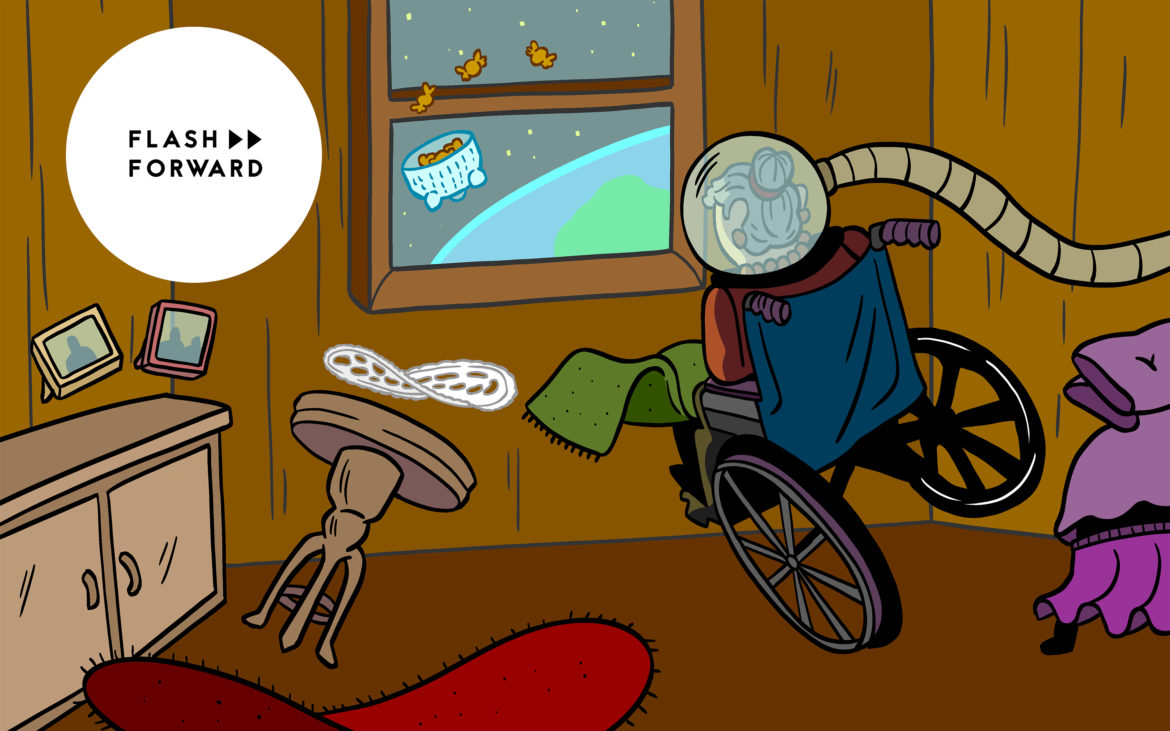
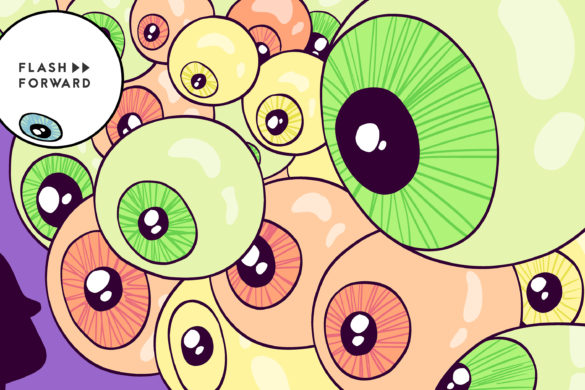
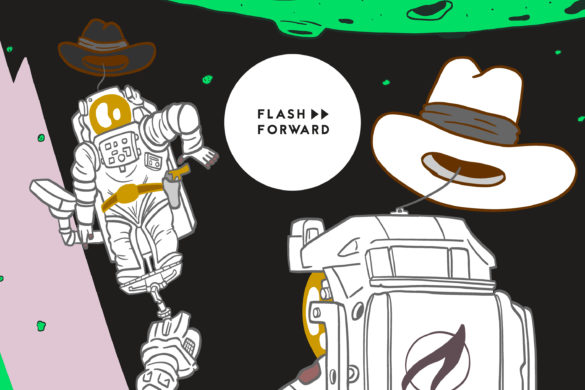
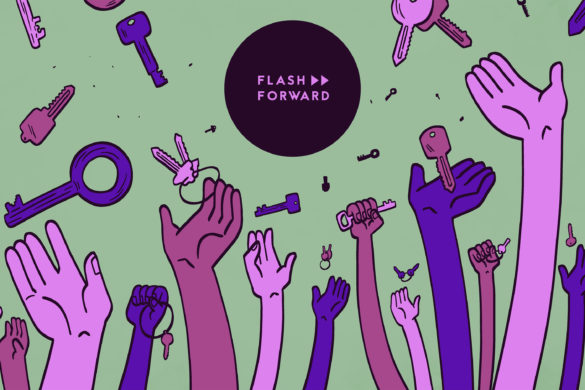
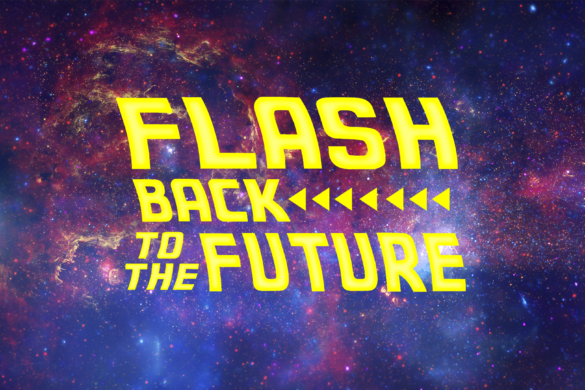
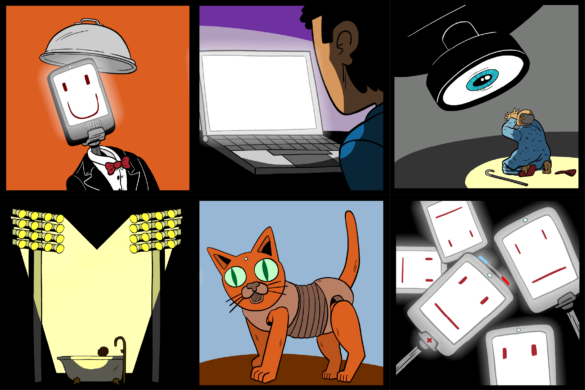
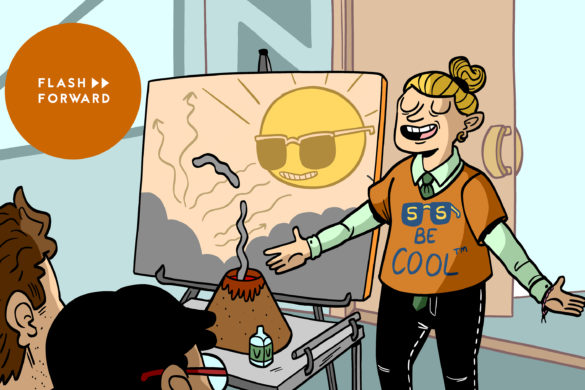
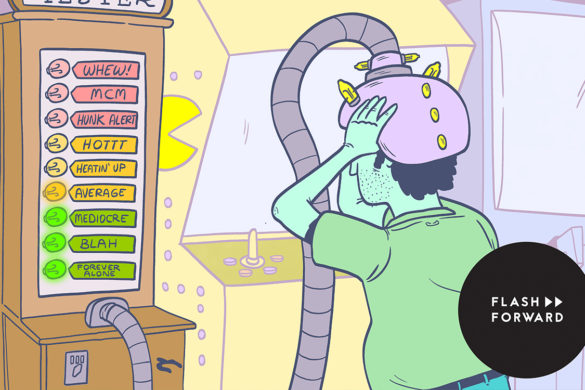
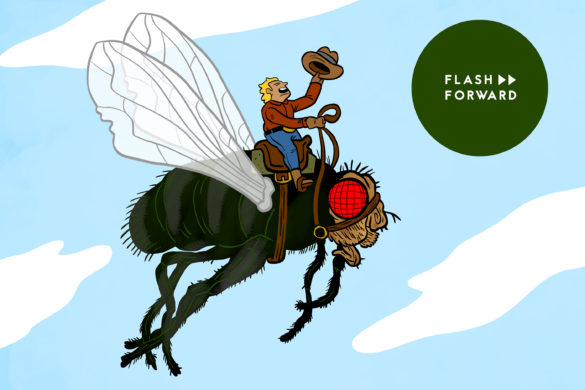
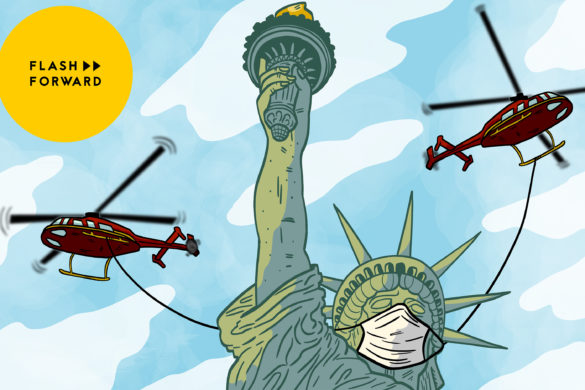
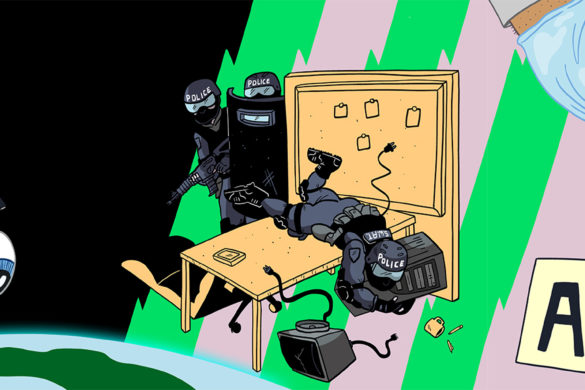
2 comments
Sorry, Love this episode but….Where is the transcript.Can’t find it.
Frustrating episode. Ignores the fact that any elderly person who retires in space would be a multimillionaire or billionaire and just as Elon Musk wouldn’t be at risk of abuse at his retirement facility in Hawaii he wouldn’t be at risk in space. Host ignores this obvious fact because it’s not fatalistic or interesting enough I guess. The parts about what happens to the body in space was very interesting.